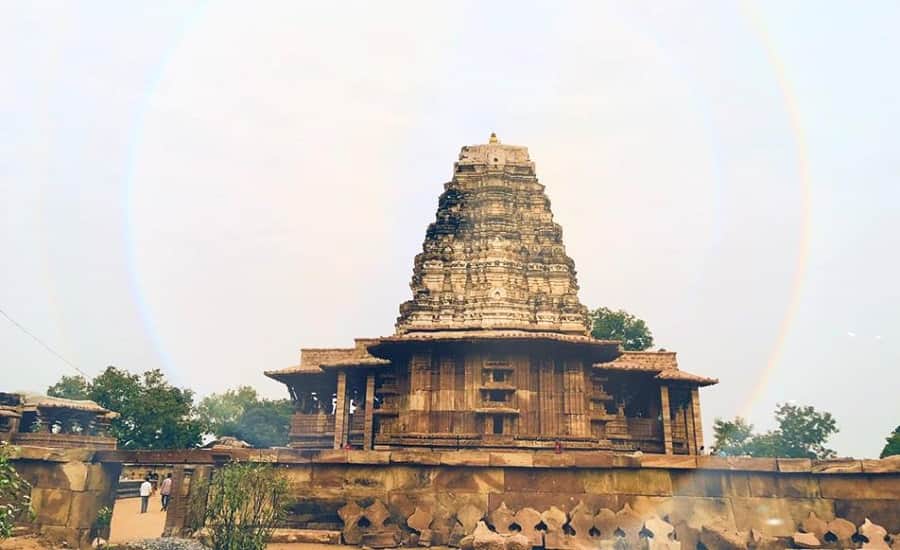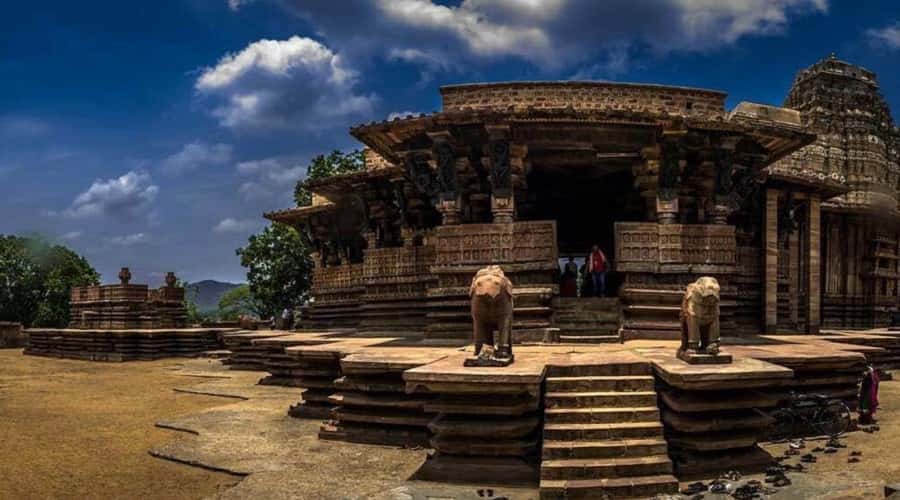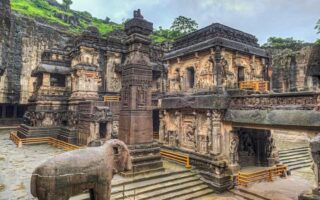Ramappa Temple, also popular as the Ramalingeswara temple, stands at a distance of 77 km from the city of Warangal that is the medieval capital of the Kakatiya Empire in the south Indian state of Andhra Pradesh. The Kakatiya kings ruled over Andhra Pradesh nearly for 200 years that takes up the time between 10th and 12th centuries. The temple, symbolizing their zeal and inclination towards art and architecture, is situated in a valley in the Palampet village of Venkatapur Mandal formerly known as the MulugTalul of the Warangal district.

History
Located at 157 km from Hyderabad, the state capital; Warangal is adorned with the architectural marvels of the Kakatiya art. The name Warangal means history and keeping the honor of its name, it still has preserved its medieval culture. Its historic glory lies in its giant fortress being unaffected despite constant attacks by the Delhi Sultans in the 13th and 14th centuries and the temples at Palampet. Today, the city and the valley have finally earned its fame in the tourist circuit for its charming lakes, wonderful temples, mud-brick citadels, and wildlife sanctuaries.
An architectural marvel, the Ramappa Temple and its adjacent Ramappa tank – a medieval engineering art piece of the 13th century both are exemplary works depicting the heights and style in the field of architecture and art achieved in the Kakatiya era. The Ramappa tank is a properly planned water pool made up of a 2000 ft deep earthen dam linking the semi-circular series of hills, which makes up a lake.
Perhaps the only temple in India to be named after its main sculptor, Ramappa – a Vishwakarma Brahmin Sthapathi of Karnataka; the temple was built by the Chief Commander RudraSamani under the benefaction of the King KakatiGanapati Deva at Ranakude in the Atukuru province. This was evident through an inscription conserved in the premises talking about the construction of the temple in the year 1213. The inscription also says that there were three more shrines namely, Kateswara, Kameswara, and Rudreswara. All of them are dedicated to Lord Shiva, the Perpetuator of Truth, as its main deity Shiva. Presently, only the main structure of Rudreswara is in a good position leaving the other two in a ruined state.
The unique wonder of this temple is despite being made up of light bricks such that they can float on water, the monument is so strong that until date it has strived well against the several wars, invasions, and natural calamities. The temple being the architecture splendor has been honored with several praises, among which the one includes entitling it as the “Brightest star in the galaxy of medieval temples in the Deccan”.
Temple’s Architecture
Erected on the star-shaped platform of 6 feet according to the cruciform plan that took 40 years for its completion, the entire monument is surrounded with a compound wall. It is planned based on the classical pattern wherein it is initially elevated on a platform that creates a line of demarcation between its sacred rituals and the daily taint. Uplifting over and above the normal level, the platform signifies the surpassing of the wicked making an adamant place for spiritual functions offered to the God.

The moment you enter the temple, a Nandi Mandapam beholds a nine feet high Nandi, the cow, the divine companion and vehicle of Lord Shiva. Nandi is present in most of the Shiva temples facing straight to the deity. However, in the Kakatiyas temples, the Nandi takes up an about to get up (alert) position and it seems as it is waiting for the command of Lord Shiva.
Adorned with a Shikhara, the sanctum is enclosed by a Pradakshina path; while the walls, pillars, and ceilings are inlaid with lush intricate patterns and sculpt work. Looking at the ceiling, the columns split the area into compartments right from the bottom. Just in front of the sanctum, there is a hall with many brilliantly carved pillars that take care of lights and space for the pilgrims. There is also a NavrangMandapam in the front of the sanctum that is approachable from an additional entrance from the north.
The east part of the sanctum is enclosed with pilasters adorned with alternate Shikhara of Dravidian and Nagara styles. Another example of lush carvings is the dark rock smoothly polished to depict a remarkable set of themes of the Indian mythology and Puranas. The walls in the temple’s exterior exhibit the artwork of rows of elephants; historic stories; and Hindi, Buddha, Jain, and Muslim folks. The other attraction is the 12 Women shrines atop the pillar in the exterior of the main temple dominating the Karnataka’s Halebidu Sculptures. For art lovers, a day is not enough to view all the carvings of the temple.
Visiting what’s Inside the Temple
Reaching the temple via a royal garden and crossing the wall on the west side as the main entrance is in ruins, you will view the boards of Archaeological Survey of India that informs you about the temple’s significance. After crossing these boards, you will come across the RangaMandapam (NatyaMandapam on to your left. From here to the Inner temple, the space holds a small room called Antharalam that can accommodate 10 members at a time for viewing and worshipping the Rudreswara (Siva Lingam) of 9 feet height in the sanctum. To its left, a screen depicts the song Sapta Swaralu. A wall of black stone splits the Antharalam and NatyaMantapam.
Originally, dedicated to Shiva; it was then presided by the deity Ramalingeswara to emphasize Shiva’s significance as the personal god of Lord Ram, the incarnation of the Lord Vishnu. The Kateswaraand Kameswara are the two small Shiva shrines on the right and left sides of the main temple. The temple resembles many features of Shiva and his imperial abode, the Himalaya Mountains spreading the importance of this Lord as having a sacred liberty beyond the worldly space.
There is a kitchen to the right of the temple. A big inscription was held in between the Kateswara Temple and the middle of Ramappa Temple written in combined Telugu and Kannada languages.
Natya Mandapam
This beholds a dance floor surrounded by black stone pillars on all its four sides that acted as the base for the ceilings. You can view the carvings of mythological events such as SamudraManthan (Churning of the cosmic Ocean), Mohini Avatar (Celestial Being Emerged from the Churning), TarakasuraSamharam (Killing of the Demon – Tarkasura), Shiva Kalyanam, Shiva’s Statues in Gajasura stomach on these pillars. The other spectacular carving is that of the Nataraja (Lord Shiva in Dance Pose) in the middle of the ceiling.
On the walls, carvings of three Women with four legs were made; whereas the pillars were adorned with circular designs, dancing women, and small holes through which only a needle could penetrate. The carvings of the dancing women look so natural and real, as if the real women are stuck to the wall. The work has no appropriate words for its description and even today its charm is retained.
Days of Attraction
The festival of MahaShivaratri is celebrated with great joy and enthusiasm here for three days. It marks the ceremony of Lord Shiva’s wedding to Goddess Parvati and comes in the month of March/April. The place echoes with the chanting of Om NamahShivaay (I bow sincerely to the Supreme and Eternal One) for all three days. Other important celebration takes place in the month of November here, regarded as the Kartik Masam – meaning the Kartik month (in Hindu calendar).
Other Attractions
Ramappa Lake is a worth seeing water pool just at a distance of 1 km from the temple. In Warangal, you can visit the Warangal Fort, Thousand Pillar Temple, Kush Mahal, and Bhadrakali Temple.
Reaching the Temple
By air, Hyderabad is the nearest airport at 157 km from Warangal. By rail, Warangal is the nearest station that is connected to major cities in the state. By road, you can catch a bus from major cities such as Secunderabad, Hyderabad, and Gowliguda.
After reaching Warangal, you can take a bus to Palampeta and then walk 1 km ahead to reach the temple. From Hyderabad, you can start in early morning and can come back until night.

